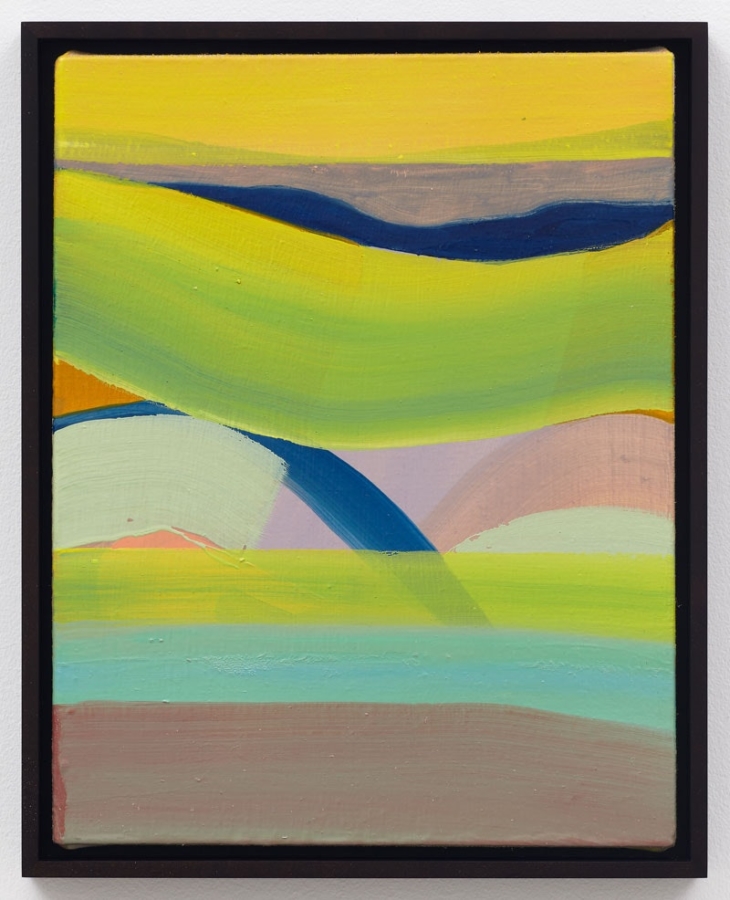June 14, 2019
Download as PDF
View on Brooklyn Rail

Marley Freeman, Sagacious Hose in the Alley, 2019, oil on linen, 12 × 11 inches. Courtesy the artist and Karma, New York.
In art, as in life, layers can both conceal history and reveal truths buried by the passage of time. Art conservators use infrared technology to seek hidden drawings beneath finished artworks. Scientists study the rings of a tree trunk to measure the plant’s age and discover unseen stress marks recorded over its life. In these ways, unpeeled layers suggest the intriguing unknown and the thrill of discovery.
Marley Freeman’s exhibition Park Closes at Midnight, at Karma Gallery, is a generous bouquet of 21 paintings that explores the depths of painting by way of its surface. Freeman’s process is at the heart of the work, and the allure of the palimpsest is at the center of the show. Diluted, crackled, thick, or wispy brushstrokes alternate between thinly-veiled expressive gestures and opaque color fields of circles, squares, and lines with surprising textures and overlays. An electric sea foam green stripe in Sagacious Hose in the Alley (2019) exemplifies her manipulation of color, at times using polarizing—yet never brash—juxtapositions. Tall Grass (2016) features vertical strokes of green and peach, bold red marks, prominent blues, gauzy whites, and a yellow dot all on a Pepto-Bismol pink base in an undulating orchestra of hues. The softness of Humaneness (2018) emerges from a pale pink nebulous that hovers in the left frame and airy green lines that resemble the path of a buzzing insect anchored by an orange hourglass shape and pinned by a black-outlined pentagon.
“Paintings are on their own time,” the press release declares, and Freeman makes a case for that point in such works, whose marks unearth a sequence of events and present an elaborate visible history that thankfully doesn’t overwhelm their fullness. The works permit for perspectival shifts, too, which challenge time by revealing paintings within paintings. Fleeced Paint (2019), for one, resembles a birds-eye view of crude vibrant patches of farmland or a flat collage of interlocking shapes. Perceptions are fleeting, and the urge to conquer an understanding of the work feels shallow. Instead, this shape-shifting is rewarding; the pictures continue to unfold and transform in complexity the longer interact with the work.
Another point the show puts forth is that, over time, works gather new meanings—as the press release states, they “collect debris” and “memory”.. Indeed, we can see the accumulation of experience in these layers. A light sweep of the artist’s hand blurs the previous gestures, so as to revise, add or fragment the moment of their action. Freeman leaves an unpainted swath of raw linen below playfully dynamic shapes in Ha Ir Re (2019) , and reminds us that all paintings are transformations of canvasses. Here, Freeman elegantly builds upon the surface of the canvas while maintaining a slice of his unencumbered point of departure.
Ampersand (2018), one of only two representational works in the exhibition, beautifully demonstrates Freeman’s ability to manipulate layers in order to deconstruct a scene while building a narrative. The marvelously bizarre painting features a creature that resembles a skeletal cat and two closely seated figures whose faces are partially obscured and whose bottom halves melt into a color-patch background. Freeman leaves the eyes of one figure visible beneath a tissue-paper-thin brush of yellow pigment and shows a cascade of brown hair on their shoulder, but hides the bottom half of their face behind a layer of paint.
The figure to the right, on the other hand, remains entirely faceless behind an opaque red-and-pink hued block. The couple appears to gingerly hold hands, and it feels as though, if we could peel back some layers, we could more deeply understand their interaction. These partially hidden signs give the figures a sense of mystery in a strange dance of suggestion, revelation, and masking, while what’s hidden beneath the surface teases and beckons us into the picture plane.
In the corner of the back gallery, we are unexpectedly compelled to reorient ourselves in the space. Freeman has artfully clustered over a hundred ceramic sculptures ranging in approximate size from an ice cube to a small ring box. The mass of objects has varying degrees and shades of marbled, earth-hued glazes and resemble an abundance of dice one would roll on blacktop. The playful connection to the real world is represented through familiar objects presently awaiting human interaction—game pieces or toys—is juxtaposed with the abstract, timeless layers of color, ideas, and forms.



